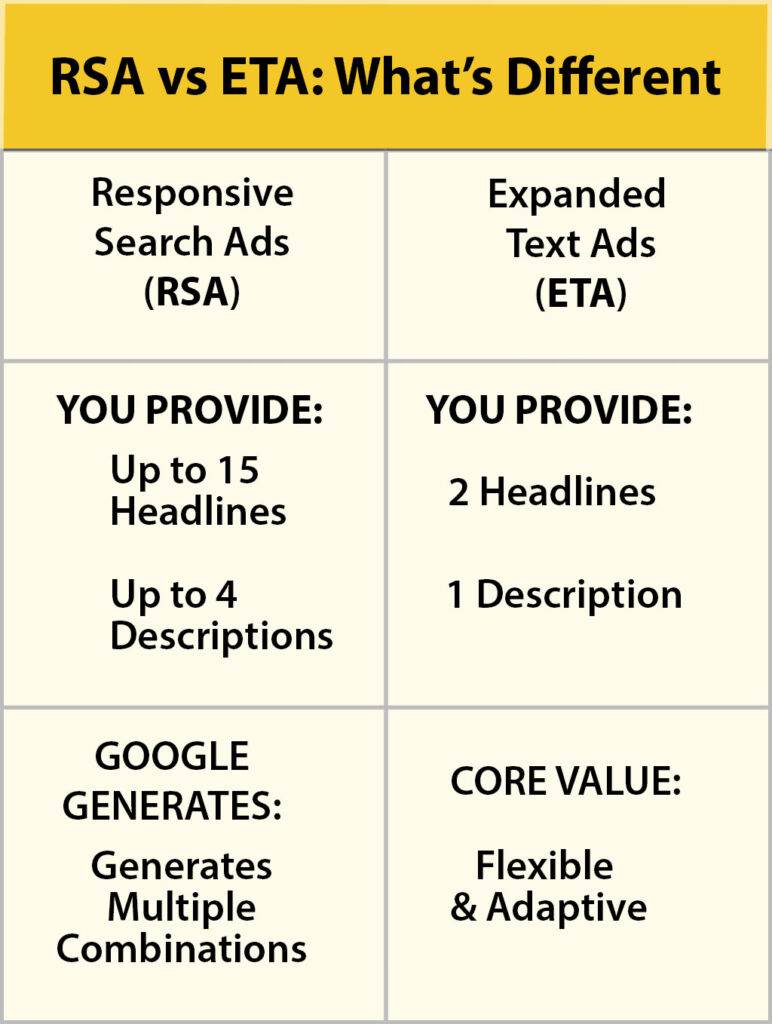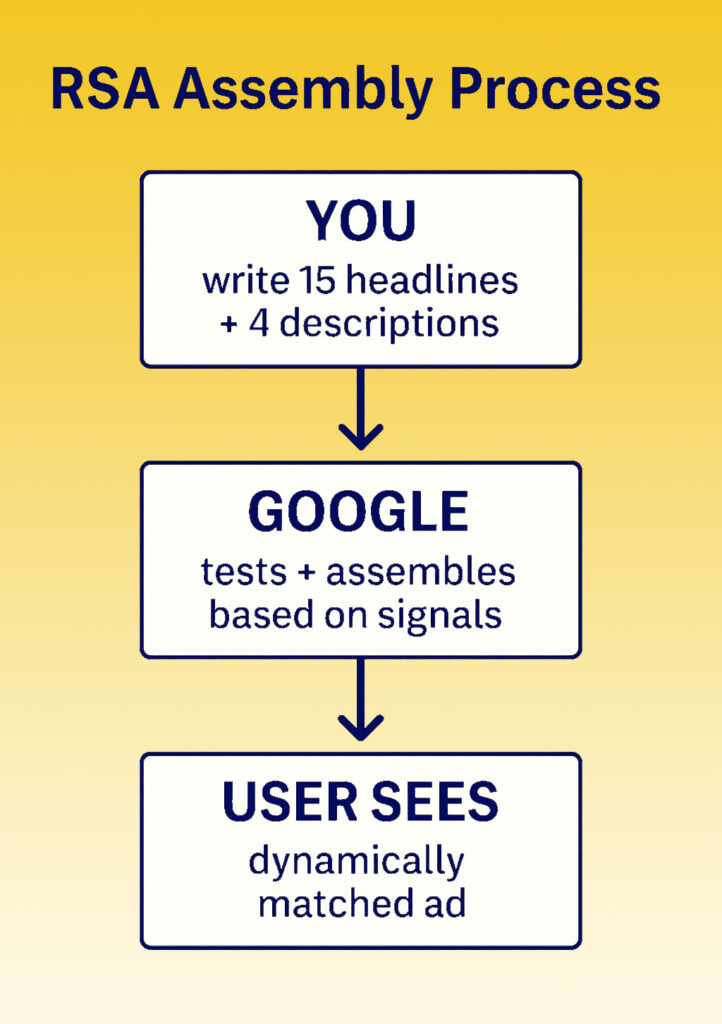Google doesn’t serve the ad you write. It assembles the ad it thinks will work.
That’s the key shift introduced by Responsive Search Ads (RSAs) — and it changes how advertisers need to write, test, and evaluate their campaigns.
Unlike Expanded Text Ads, which were fully predefined, RSAs function more like modular building blocks. You provide components — headlines and descriptions — and Google takes it from there.
What Actually Happens When You Create an RSA

When building a Responsive Search Ad, you’re asked to submit:
- Up to 15 headlines
- Up to 4 descriptions
From there, Google’s algorithm can generate tens of thousands of combinations — technically, up to 43,680. But it doesn’t test every possible variant. Instead, it uses real-time signals (query context, user device, location, and past performance) to experiment and optimize over time.
This isn’t about showing the “best” ad. It’s about showing the most relevant one — for that particular search and moment.
Why RSAs Matter Now More Than Ever
The strength of RSAs lies in adaptability. In a world of constantly shifting user behavior and intent, they offer:
- Broader query coverage without bloating your ad groups
- Automated message matching to user context
- Faster learning loops without needing manual A/B testing
- Cross-device performance from a single creative pool
But the trade-off is control. You don’t get to pick the final message. Instead, you influence it — through input quality.
The Difference Between Strong and Weak RSAs
Most advertisers make the same mistake: they enter 15 versions of the same headline with slightly different phrasing.
Google then has no real variability to test.
To make RSAs work, your headlines need range — across tone, intent, message, and position in the funnel.

Best Practices That Actually Drive Results
1. Prioritize variation, not volume
Every headline should serve a distinct function. Include a mix of:
- Value propositions: “Same-Day Results. No Delay.”
- Trust signals: “Used by 10,000+ Businesses”
- Calls to action: “Book Your Free Audit Today”
- Objection handling: “No Hidden Fees or Contracts”
2. Think in modular units
Since any 2–3 headlines might appear together, ensure each line works independently. Avoid setups that rely on specific sequences like:
Headline 1: “Looking for Better Hosting?”
Headline 2: “We Have the Answer” → Without context, this reads poorly on its own.
3. Use pinning wisely
Yes, you can force your brand to always show in Headline 1. But avoid over-pinning — it restricts Google’s learning and reduces ad performance. Only pin critical lines.
4. Preview before you launch
Use the preview tool in Google Ads to view real-world combinations. If they feel jumbled or redundant, revise before going live.How to Measure and Optimize RSA Performance
Don’t stop at CTR. It might tell you how often people click, but it doesn’t tell you if those clicks matter. To truly understand whether RSAs are performing, monitor more meaningful signals:
Conversion rate (CVR) at the ad group level
Clicks mean little if they don’t convert. Track how each RSA contributes to actual business outcomes within its ad group. Low CVR despite high traffic often signals misaligned messaging or poor audience intent.
Asset performance labels (e.g. Best, Good, Low)
Google evaluates individual headlines and descriptions based on user interaction. Assets marked “Best” have consistently driven results, while “Low” performers drag overall effectiveness down. Regularly rotate or rewrite underperformers.
Search term reports to identify which queries drive meaningful engagement
Understanding which actual search queries triggered your RSA helps reveal if your message is showing for relevant intent. Irrelevant or off-topic queries may inflate metrics without real value.
Click share & impression strength to assess competitiveness
Click share indicates how often your ad is clicked versus competitors. Impression strength reflects how well your RSA assets align with the query and auction environment. Weak performance here usually points to under-optimized creative inputs.
Underperforming assets should be paused or replaced regularly.
Even good RSAs degrade over time. Keep testing and refreshing copy. RSAs aren’t set-it-and-forget-it — they’re iterative and require hands-on maintenance to stay effective.
The Real Point: RSAs Aren’t “Automated Ads.” They’re Strategic Experiments
Think of RSAs as multivariate tests at scale. Instead of running isolated A/B campaigns, you give Google a set of ingredients, and it tests combinations across thousands of searches.
You’re not losing control — you’re gaining speed. But that only helps if you:
Write with intent
Each headline or description should express a clear purpose: solve a problem, build trust, prompt action, or qualify intent.
Feed the system with variety
Avoid repeating the same idea with minor wording changes. Provide a diverse mix of messages that can cover multiple user scenarios and funnel stages.
Track asset-level data, not just ad-level outcomes
Zoom in. Campaign-level performance hides what’s actually working. Use Google’s reporting to isolate individual asset contributions.
Keep refining based on how Google actually delivers your ads
Observe how different combinations behave in real-world auctions and tweak inputs accordingly. RSAs evolve — your inputs should too.
What We Do at 3MY

At 3MY, we treat RSAs as part of a broader performance strategy — not a checkbox.
Here’s our approach:
Segment assets by intent and funnel stage
We align each message with a specific moment in the buyer journey. That way, the right combination can meet users at the right intent level.
Craft unique, persuasive copy for each message type
We don’t copy-paste synonyms. We create variation with purpose: trust-builders, objections handled, CTAs, pain points, and benefits — all distinct.
Track performance at the asset level, not just the campaign level
Our analysis doesn’t stop at conversions. We break down performance per asset to find which exact headlines or descriptions drive results.
Test RSAs alongside manual ads for real comparison data
We don’t assume RSAs are better. We run fixed ads in parallel to get real benchmarks and validate impact — with data, not guesswork.
We don’t trust Google blindly.
But we do leverage its machine learning — when guided by human strategy. Because automation is powerful only when it’s built on thoughtful input.
Not Sure If Your RSAs Are Doing the Job?
Most accounts we audit have RSAs running quietly in the background — with vague results. If you haven’t looked at asset performance, pinning logic, or search term matching in a while, it might be time for a check-in.
[Book a Mini Audit →]
We’ll analyze what Google is actually showing, evaluate each asset’s contribution, and give you a clear report on what’s working — and what needs fixing.









